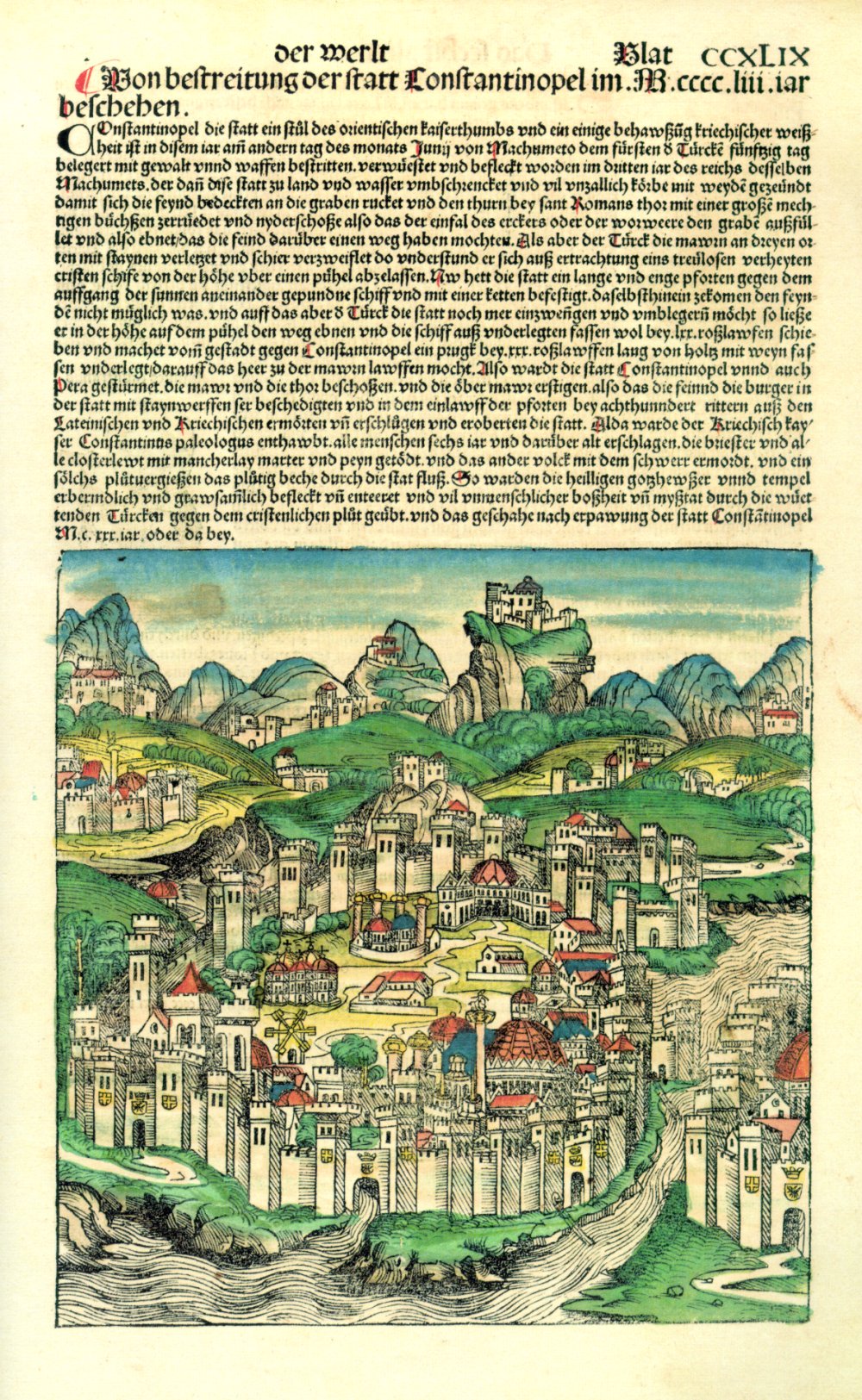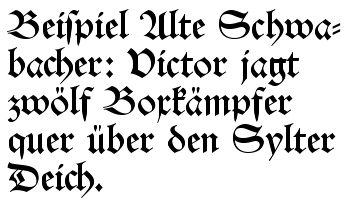Schwabacher on:
[Wikipedia]
[Google]
[Amazon]
 The
The
 Similar to Rotunda, the rounded Schwabacher types were nearer to handwriting than the former Textualis style, though it also includes sharp edges. The lower-case ''g'' and upper-case ''H'' have particularly distinctive forms. In the context of German language texts, Schwabacher appeared vibrant and popular.
Similar to Rotunda, the rounded Schwabacher types were nearer to handwriting than the former Textualis style, though it also includes sharp edges. The lower-case ''g'' and upper-case ''H'' have particularly distinctive forms. In the context of German language texts, Schwabacher appeared vibrant and popular.
 The statement ignores the fact that Schwabacher originated from the earlier Rotunda blackletter script and late medieval Bastarda types. Actually, there is no evidence of any connection between Jews and the Schwabacher typeface. At the time of its origin the ownership of printing houses was reserved for Christian citizens.
The statement ignores the fact that Schwabacher originated from the earlier Rotunda blackletter script and late medieval Bastarda types. Actually, there is no evidence of any connection between Jews and the Schwabacher typeface. At the time of its origin the ownership of printing houses was reserved for Christian citizens.
 The German sentence in the figures reads: " xample of Old Schwabacher ". This is a nonsense sentence meaning "Victor chases twelve boxers across the dike of Sylt", but contains all 26 letters of the alphabet plus the German umlauts and is thus an example of a
The German sentence in the figures reads: " xample of Old Schwabacher ". This is a nonsense sentence meaning "Victor chases twelve boxers across the dike of Sylt", but contains all 26 letters of the alphabet plus the German umlauts and is thus an example of a
pdf
* Philipp Luidl: ''Die Schwabacher – Die ungewöhnlichen Wege der Schwabacher Judenletter''. Maro Verlag, Augsburg 2004. * ''"Vergessen und verdrängt" Schwabach 1918-1945,'' Ausstellungskatalog Stadtmuseum Schwabach, p. 172
 The
The German
German(s) may refer to:
* Germany (of or related to)
**Germania (historical use)
* Germans, citizens of Germany, people of German ancestry, or native speakers of the German language
** For citizens of Germany, see also German nationality law
**Ge ...
word Schwabacher (pronounced ) refers to a specific style of blackletter
Blackletter (sometimes black letter), also known as Gothic script, Gothic minuscule, or Textura, was a script used throughout Western Europe from approximately 1150 until the 17th century. It continued to be commonly used for the Danish, Norwe ...
typeface
A typeface (or font family) is the design of lettering that can include variations in size, weight (e.g. bold), slope (e.g. italic), width (e.g. condensed), and so on. Each of these variations of the typeface is a font.
There are thousands o ...
s which evolved from Gothic Textualis (''Textura'') under the influence of Humanist
Humanism is a philosophical stance that emphasizes the individual and social potential and agency of human beings. It considers human beings the starting point for serious moral and philosophical inquiry.
The meaning of the term "human ...
type design in Italy
Italy ( it, Italia ), officially the Italian Republic, ) or the Republic of Italy, is a country in Southern Europe. It is located in the middle of the Mediterranean Sea, and its territory largely coincides with the homonymous geographical ...
during the 15th century. Schwabacher typesetting was the most common typeface in Germany, until it was replaced by Fraktur
Fraktur () is a calligraphic hand of the Latin alphabet and any of several blackletter typefaces derived from this hand. The blackletter lines are broken up; that is, their forms contain many angles when compared to the curves of the Antiq ...
from the mid 16th century onwards.
Etymology
The term may derive from theFranconia
Franconia (german: Franken, ; Franconian dialect: ''Franggn'' ; bar, Frankn) is a region of Germany, characterised by its culture and Franconian dialect (German: ''Fränkisch'').
The three administrative regions of Lower, Middle and Upper ...
n town of Schwabach
Schwabach () is a German city of about 40,000 inhabitants near Nuremberg in the centre of the region of Franconia in the north of Bavaria. The city is an autonomous administrative district (''kreisfreie Stadt''). Schwabach is also the name of th ...
, where, in 1529, the Articles of Schwabach
Beginning in July 1529,Johann Michael Reu, ''The Augsburg Confession'' (1930), p. 28. Philipp Melanchthon, along with Martin Luther and probably Justus Jonas, wrote the Articles of Schwabach (so named because they were presented at the Convention o ...
, a Lutheran
Lutheranism is one of the largest branches of Protestantism, identifying primarily with the theology of Martin Luther, the 16th-century German monk and reformer whose efforts to reform the theology and practice of the Catholic Church launched ...
creed, were adopted. The Articles became the basis of the 1530 Confessio Augustana
The Augsburg Confession, also known as the Augustan Confession or the Augustana from its Latin name, ''Confessio Augustana'', is the primary confession of faith of the Lutheran Church and one of the most important documents of the Protestant Ref ...
, and possibly also promoted the use of Schwabacher types.
Characteristics
History
While the LatinGutenberg Bible
The Gutenberg Bible (also known as the 42-line Bible, the Mazarin Bible or the B42) was the earliest major book printed using mass-produced movable metal type in Europe. It marked the start of the " Gutenberg Revolution" and the age of printed ...
was still set in Textualis type, the oldest preserved Schwabacher incunable
In the history of printing, an incunable or incunabulum (plural incunables or incunabula, respectively), is a book, pamphlet, or broadside that was printed in the earliest stages of printing in Europe, up to the year 1500. Incunabula were pro ...
dates from 1472, and was printed in Augsburg
Augsburg (; bar , Augschburg , links=https://en.wikipedia.org/wiki/Swabian_German , label=Swabian German, , ) is a city in Swabia, Bavaria, Germany, around west of Bavarian capital Munich. It is a university town and regional seat of the ' ...
. Schwabacher types appeared in the Free Imperial City of Nuremberg
The Imperial City of Nuremberg (german: Reichsstadt Nürnberg) was a free imperial city — independent city-state — within the Holy Roman Empire. After Nuremberg gained piecemeal independence from the Burgraviate of Nuremberg in the High Midd ...
from about 1485: Anton Koberger
Anton Koberger (c. 1440/1445 – 3 October 1513) was the German goldsmith, printer and publisher who printed and published the ''Nuremberg Chronicle'', a landmark of incunabula, and was a successful bookseller of works from other printers. In 147 ...
(–1513) used them for the publication of the ''Nuremberg Chronicle
The ''Nuremberg Chronicle'' is an illustrated encyclopedia consisting of world historical accounts, as well as accounts told through biblical paraphrase. Subjects include human history in relation to the Bible, illustrated mythological creatures, ...
'' (in both Latin and German) in 1493, and Albrecht Dürer
Albrecht Dürer (; ; hu, Ajtósi Adalbert; 21 May 1471 – 6 April 1528),Müller, Peter O. (1993) ''Substantiv-Derivation in Den Schriften Albrecht Dürers'', Walter de Gruyter. . sometimes spelled in English as Durer (without an umlaut) or Due ...
(1471–1528) for his ''Apocalypse
Apocalypse () is a literary genre in which a supernatural being reveals cosmic mysteries or the future to a human intermediary. The means of mediation include dreams, visions and heavenly journeys, and they typically feature symbolic imager ...
'' series in 1498. Schwabacher became widely known with the spread of Luther Bible
The Luther Bible (german: Lutherbibel) is a German language Bible translation from Latin sources by Martin Luther. The New Testament was first published in September 1522, and the complete Bible, containing the Old and New Testaments with Apocry ...
s from 1522.
After Schwabacher was displaced by Fraktur as the most-used German language type style from about 1530, it remained in common use as a secondary typeface for emphasis in a similar way to italic.Steinberg, S. H. (1961) ''Five Hundred Years of Printing''; 2nd ed. Penguin Books; p. 41 It was still used occasionally until the mid 20th century.
When the Nazis
Nazism ( ; german: Nazismus), the common name in English for National Socialism (german: Nationalsozialismus, ), is the far-right totalitarian political ideology and practices associated with Adolf Hitler and the Nazi Party (NSDAP) in N ...
officially abandoned the widely used Fraktur type by Martin Bormann
Martin Ludwig Bormann (17 June 1900 – 2 May 1945) was a German Nazi Party official and head of the Nazi Party Chancellery. He gained immense power by using his position as Adolf Hitler's private secretary to control the flow of information ...
's ' of 3 January 1941, it was called ' ("Jew-letters of Schwabach"):
 The statement ignores the fact that Schwabacher originated from the earlier Rotunda blackletter script and late medieval Bastarda types. Actually, there is no evidence of any connection between Jews and the Schwabacher typeface. At the time of its origin the ownership of printing houses was reserved for Christian citizens.
The statement ignores the fact that Schwabacher originated from the earlier Rotunda blackletter script and late medieval Bastarda types. Actually, there is no evidence of any connection between Jews and the Schwabacher typeface. At the time of its origin the ownership of printing houses was reserved for Christian citizens.
Samples
 The German sentence in the figures reads: " xample of Old Schwabacher ". This is a nonsense sentence meaning "Victor chases twelve boxers across the dike of Sylt", but contains all 26 letters of the alphabet plus the German umlauts and is thus an example of a
The German sentence in the figures reads: " xample of Old Schwabacher ". This is a nonsense sentence meaning "Victor chases twelve boxers across the dike of Sylt", but contains all 26 letters of the alphabet plus the German umlauts and is thus an example of a pangram
A pangram or holoalphabetic sentence is a sentence using every letter of a given alphabet at least once. Pangrams have been used to display typefaces, test equipment, and develop skills in handwriting, calligraphy, and keyboarding.
Origins
The ...
.
Notes and references
Further reading
* Friedrich Beck: ''„Schwabacher Judenlettern“ - Schriftverruf im Dritten Reich''. in: Die Kunst des Vernetzens, Verlag für Berlin-Brandenburg, 2006,* Philipp Luidl: ''Die Schwabacher – Die ungewöhnlichen Wege der Schwabacher Judenletter''. Maro Verlag, Augsburg 2004. * ''"Vergessen und verdrängt" Schwabach 1918-1945,'' Ausstellungskatalog Stadtmuseum Schwabach, p. 172
External links
* {{Typography terms Blackletter Blackletter typefaces German orthography